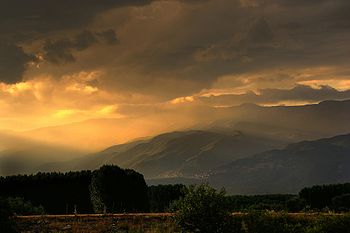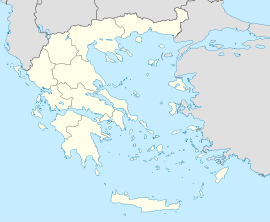- Ano Poroia
-
Ano Poroia
Άνω ΠορόιαLocation Coordinates 41°17′N 23°2′E / 41.283°N 23.033°ECoordinates: 41°17′N 23°2′E / 41.283°N 23.033°E Government Country: Greece Region: Central Macedonia Regional unit: Serres Municipality: Sintiki Municipal unit: Kerkini Population statistics (as of 2001) Community - Population: 1,529 Other Time zone: EET/EEST (UTC+2/3) Elevation (center): 380 m (1,247 ft) Postal: 620 55 Telephone: 23270 Auto: ΕΡ Website www.dimoskerkinis.gr/ Ano Poroia (Greek: Άνω Πορόια, Aromanian: Foroi, Bulgarian: Горни Порой, Gorni Poroy or Горни Порој, Gorno Poroj) is a village in Greece, located in Macedonia. The population was 1,529 people (2001). The name literally means "Upper Downpour" in contemporary Bulgarian.
Contents
Geography
The village is located 55 km and 30 km respectively to the Northwest of the town of Serres and to the west of Sidirokastro. It is at the foot of the Belasitsa (Beles or Kerkini) at an altitude of 380 m. Lake Kerkini (Butkovsko lake) is to the south of Ano Poroia.
History
Ano Poroia was founded in the end of the 18th century (c.1800),by Vlachs (at the most) of Pindus mountain after expulsions led by Ali Pasha of Ioannina. During the 19th century the village was one of the largest and developed in Demirhisar Kaza of the Serres Sandjak. The main occupation was farming (tobacco, flax, cotton, barley, rye), sericulture, and commerce. The population was composed of Bulgarians , Vlachs and Turks.
In "Ethnographie des vilayets d'Adrianople, de Monastir et de Salonique" (issued in Constantinople in 1878 and concerning the population in 1873) it was written that Gorni Poroi was a village, and had 320 households with 1,000 Bulgarians and 60 Vlachs.[1] Gustav Weigand -German linguist and specialist in Balkan languages (esp.Bulgarian and Aromanian)- passed during early 20th century.He mentions 750 households.450 of them Bulgarian,200 Vlachic and 100 Turkish.[2]
At first both Bulgarians and Vlachs heard the same liturgy and they belonged to a unified church that was serving in Greek.
The oldest school that ever existed in the village is mentioned in 1819.It was a Greek elementary school that was attended by Vlachs and a few Bulgarian children of the wealthier class. The first conflict between Bulgarians and Greekophiles was registered in 1883, when Bulgarians tried and achieved to separate from the Greek church and education and regenerate their own. According to Vasil Kanchov, in 1891 the village had two Bulgarian churches (serving in Church-Slavonic) and a Vlach church (serving in Greek). There were two Bulgarian elementary schools, and one Greek elementary school that was attended by Vlachs.[3] According to Kantchov, there were 3,780 people living in the village around 1900. 2,200 of them were Bulgarian, 480 were Turkish, and 1,100 Vlachs.[4]
Around the turn of the 20th century, the Bulgarian people in Gorni Poroi were within the borders of the Bulgarian Exarchate, and the Vlachs had their own Romanian Parish and they were engaged in a conflict with the Bulgarians.[5] According to Dimitar Mishev, the secretary of the exarchate, in 1905 there were 3,840 Bulgarian exarchatists, 25 Greeks, and 750 Vlachs. There was a Greek elementary school and a Bulgarian elementary and middle-high school.[6]
The 7th Rila Division liberated the village from the Ottoman Empire in October 1912, during the First Balkan War. During the Second Balkan War, on the 9th of July, 1913, Gorni Poroy was set on fire by the Greek army.[7]
After the war, the village remained within the borders of Greece.A large portion of the Bulgarian population, as well some Vlachs, emigrated to Bulgaria. They went primarily to the towns of Petrich, Blagoevgrad, and Plovdiv, and to the villages on the northern slopes of Belasitsa, Belasitsa, Kolarovo, Samuilovo, Klyuch, Skrat.In 1913 according to the Greek statistic ministry there were 2.684 Greeks in the village (including Vlachs). In the 1920s, Greek refugees from Asia Minor settled down in the village.
Born in Ano Poroia
 Ano Poroia, view from lake Kerkini
Ano Poroia, view from lake Kerkini
- Ivancho voivoda (1848–1896), Bulgarian revolutionary
- Yordan Ivanov (1908 - ?), Bulgarian chemist, professor at Sofia University
- Petros Penas (1902–1994), Greek historian
- Dimitrios Itsios (1906–1941), Greek soldier who murdered by Nazis [8]
Notes
- ^ „Ethnographie des vilayets d'Adrianople, de Monastir et de Salonique“. Constantinople, 1878
- ^ (1908): Linguistischer Atlas des dacorumänischen Sprachgebiets. Leipzig: Barth.
- ^ Васил Кънчов. „Пътуване по долините на Струма, Места и Брегалница“.
- ^ Васил Кънчов. „Македония. Етнография и статистика“. София, 1900.
- ^ Доклад на Андрей Тошев, в: История на българите в документи, Съставители Величко Георгиев и Стайко Трифонов, т. І, ч. ІІ, София 1996, с. 307
- ^ D.M.Brancoff. "La Macedoine et sa Population Chretienne". Paris, 1905, p.188-189.
- ^ Carnegie Endowment for International peace. Report to inquire into the causes and Conduct of the Balkan Wars
- ^ The story of Itsios-in greek
Categories:- Populated places in Serres (peripheral unit)
Wikimedia Foundation. 2010.

